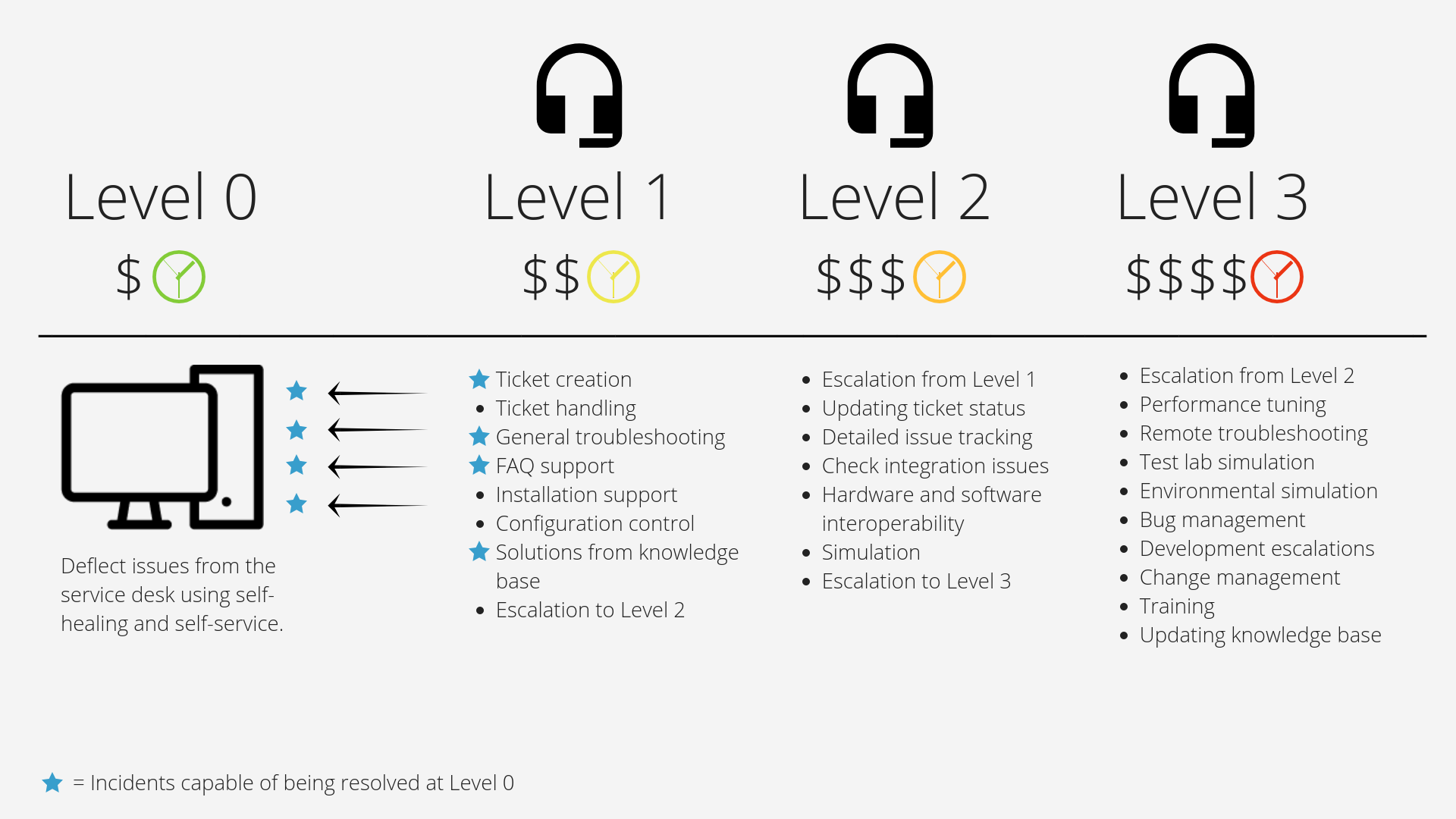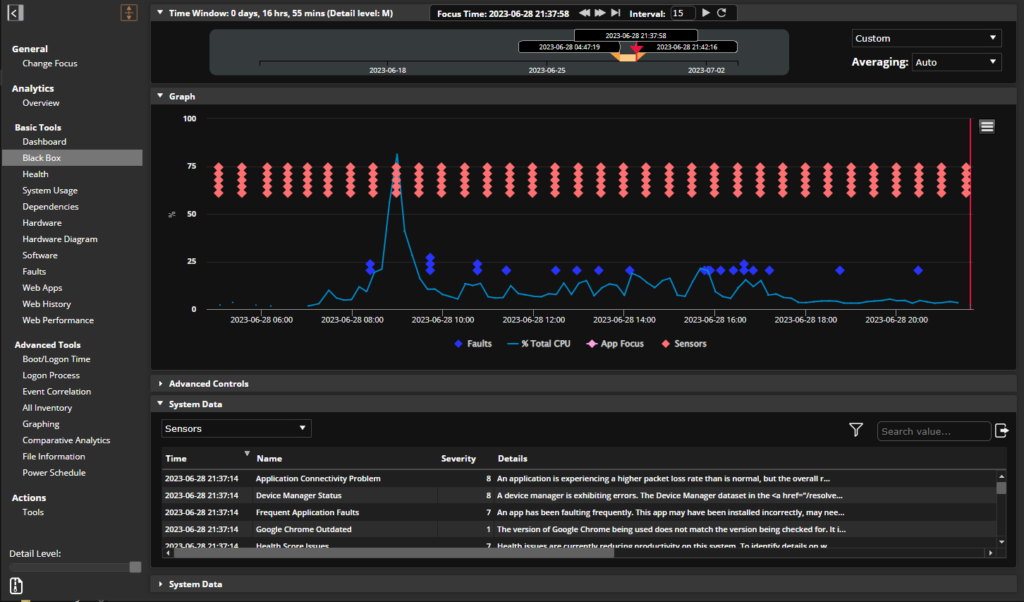
It’s a running gag in IT that end users tend to ask for help with the same few things: “My computer is slow,” “I can’t connect to the printer,” etc. The goal of Level 0 support is to lessen some of those pain points by resolving incidents before they reach the service desk through a combination of IT self-service and self-healing.
When end users contact IT for help, it’s not necessarily because they’re incapable of solving the problem themselves. Often, there’s simply no good process in place for them to do so.
We’re used to self-service in our everyday lives. Forgot your password? No problem. Click a link, open an email, and reset it yourself. This functionality is sometimes missing in the enterprise, particularly with custom-built applications.
Alternatively, self-healing decreases end-user involvement, but the intent is the same: deflect incidents away from Level 1. Self-healing is a form of IT automation where scripting is used to detect and resolve well-known issues without human intervention.
Through self-service and self-healing, Level 0 extends the “shift-left” approach within the support tiers model, which often includes Levels 1,2, and 3. By strategically moving incident resolution closer to the source, organizations can lower IT support costs, free up higher-level IT staff to focus on other projects, improve end-user experience, and help end users get back to work sooner.
Do You Need Level 0? Ask Yourself These Questions
Does your organization have…
- high ticket volumes for repeat incidents?
- high numbers of incidents that are generally easy to resolve, such as trouble connecting to peripherals?
- a global workforce that may not have access to live 24/7 IT support?
- users that require anytime, anywhere access to their technology?
- room for improvement in service quality and end-user satisfaction?
If your IT team deals with any of the above challenges, Level 0 support could help.
What Level 0 Support Looks Like
To illustrate how Level 0 would operate in an everyday IT support scenario, let’s look at different ways of approaching the same incident. Say a user is experiencing performance degradation and application crashes due to low disk space. Depending on the organization’s practices, here are several ways the issue could be resolved:
- The user attempts to solve the issue herself (without self-service resources). The user may have followed the system’s prompts to clear out old files but is still left with low space that quickly fills up as she continues working. She doesn’t know that her application issues are related to low disk space and contacts IT support.
- The user contacts IT support (Level 1). The user calls or emails the service desk to file a ticket. A Level 1 technician files the ticket and it is placed in a queue. Assuming no higher-priority items are called in, a technician investigates the user’s system and finds the disk issue along with large video files in the user’s downloads folder. The technician instructs the user to remove these files if no longer needed.
- IT notices the issue and solves it proactively (Level 2). A Level 2 technician receives a notification that the user is experiencing a high number of application crashes. The technician investigates the user’s system and discovers that low disk space is the root cause of the issue. They contact the user and suggest deleting large files or moving them to a drive with more free space.
- The user attempts to solve the issue herself (with self-service resources; Level 0). The user consults the organization’s end-user-facing knowledge base for information on application crashes.
- If she locates an answer, the user checks for drives with more free space, deletes old downloads, and empties her trash.
- If she cannot locate an answer, or if the fix she found doesn’t work, the user contacts IT.
- IT has an automated disk clean up script in place (Level 0). Knowing that the organization has provisioned small drives, IT creates a script to run whenever free disk space falls below 10%. The user receives a notification asking if they would like to clear up space by removing downloads older than 14 days.
Even in this simple example, there are many possible paths for resolving the same incident. What path resolution will take depends on whether the organization supports Level 0, the quality of self-service resources, a user’s technical knowledge, and IT’s level of visibility into the issue.
Creating a Self-Service Culture
Organizations that already provide FAQ pages and/or knowledge base articles for end users will know that self-service can be tricky to get right. Self-service is only as valuable as it is usable, which means that any resources provided must satisfy several criteria:
- A high probable success rate (successful resolutions encourage users to continue to perform self-service)
- Easy to use (intuitive UX design; uses end-user-friendly terms)
- Easily accessible (resources are housed in one central location; good search functionality)
Additionally, users must be enabled and encouraged to use self-service resources through marketing and training. IT staff also must continue to manage and update knowledge base articles to ensure their relevancy.
Ultimately, the goal of self-service is not to push the responsibility of resolving incidents onto the end user. Rather, self-service should ideally improve end-user experience and productivity by helping end users solve problems more quickly and painlessly than a traditional IT interaction.
Self-Healing: To Automate or Not to Automate?
The issue with automation in IT has not been lack of interest so much as a shortage of viable solutions. One of the main setbacks to implementing self-healing is insufficient visibility into the current state of users’ systems and the issues they’re experiencing. Tickets and one-on-one interactions with end users only reveal so much. To understand potential use cases for automation in a service context, you need data on system usage and performance.
Consider the earlier example of a self-healing script that clears up disk space. To execute that script, you need 1) knowledge of whether low disk space is a common issue, 2) a mechanism to detect when disk space falls below a pre-defined threshold, and 3) a way to tie the script to the low disk space alarm so that it triggers automatically. These steps all require timely, detailed endpoint data.
Other examples of automation include starting/stopping services and restarting a system. In all cases, it’s imperative to consider how the script will affect the end user. For instance, it could be necessary to know whether the user is online, whether they are actively using an application, and what applications are most important to them (i.e. most actively used) to ensure that automation is not prioritized over end-user experience.
Some Benefits of Level 0
A well-executed Level 0 support practice brings the following benefits:
- Cost reduction: Level 0 helps optimize the support cycle by better matching incidents to the appropriate support tier. Incidents are resolved faster and at lower tiers, decreasing the cost associated with resolving the incident and lowering costs associated with downtime.
- Better quality of service: By reducing Level 1 incident volume, Level 0 makes it possible for technicians to tackle more critical issues as they arise, decreasing time-to-resolution. Self-healing also enables issues to be addressed proactively before an end user notices a problem.
- Improved end-user experience: Level 0 incorporates popular aspects of the consumer experience into enterprise IT. Robust self-service resources enable end users to more seamlessly resolve common issues.
- Enhanced service desk operations: Shifting left to Level 0 helps each support tier focus on work that will provide the most value to the organization. For Level 2 and Level 3, deflecting support requests means more time for higher-value IT projects and core engineering work.
Why Digital Experience Monitoring Is Essential
As with many pervasive IT challenges, IT support has struggled with 1) a lack of visibility into what is causing problems and 2) a lack of the quality data needed to resolve them. Without adequate data, IT’s only path for resolving issues is to involve the end user, sparking a back-and-forth that eats into productivity on both sides.
Here are some ways digital experience monitoring (DEM) helps with Level 0:
- Gathering data to inform the creation of KB articles and self-healing scripts. DEM provides insight into system and application performance as well as usage and end-user experience.
- Identifying common problems. DEM tools surface the incidents happening most frequently as well as ones that affect large amounts of users. They can also be used to quantify the impact of various issues in terms of lost productivity.
- Understanding the diverse needs of different user populations. DEM helps you segment users by persona, enabling you to better target candidates for self-healing.
- Integrating with ITSM tools. DEM tools can be used alongside ITSM solutions to integrate seamlessly into the support process, including providing more context for Level 1 support to potentially stop incidents from escalating as well as matching issues to the appropriate support level faster.
- Judging the success of the Level 0 implementation. DEM shows whether Level 0 is positively impacting performance and end-user experience.
Now that you’re a Level 0 pro, it’s time to evaluate how your organization could benefit from IT self-service and self-healing. Sign up for a free SysTrack demo to see how digital experience monitoring can help you achieve the benefits of a Level 0 approach.
You may also be interested in…
Subscribe to the Lakeside Newsletter
Receive platform tips, release updates, news and more




